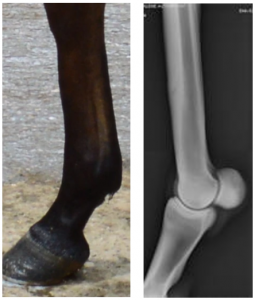Equine bone disorders
Dorsal cortical fractures
Bucked shins, aka dorsal metacarpal disease, are actually remodeling from dorsal cortical fractures of the cannon bone. As cortical fractures, these fracture extend only into the cortex, not across the entire bone. This disorder is almost exclusively seen in young Thoroughbreds in race training. I have no idea why they are called bucked shins.
Clinical findings

Clinical signs include lameness and pain on palpation of the dorsal cannon bone.
Radiographically, the dorsal cortex of MC III is thickened.
Most horses will not have obvious fractures on radiographs but some will have one or more radiolucent lines in the dorsal cortex identified as “stress fractures”. These are usually seen in 3 year old racehorses that experienced bucked shins as 2 year olds. Occasionally the fracture line will curve back to the surface, creating a true saucer fracture.
Therapy
Treatment includes a revised training regimen and NSAIDs unless stress fractures are evident. If fracture lines are evident, the horse is stall rested until periosteal callus bridges the fracture line. This is most likely to occur in the distal or proximal metaphyseal regions. Osteostixis is used when the fracture isn’t healing and for saucer fractures. Osteostixis involves drilling through the cortex to stimulate local bone repair mechanisms. Orthopedic screws may be placed across the fracture. The horse is stall rested for 4-6 weeks. Screws are removed and light work is maintained for another 60 days before return to race training.

Key Takeaways
Bucked shins are seen in racehorses in training. Dorsal cortical fractures occur due to overloading of the cannon bone. Radiographically the dorsal cortex is thickened. Cases without stress fractures are treated by a revised training regimen and NSAIDs. Osteostixis can be performed to encourage healing if needed.

